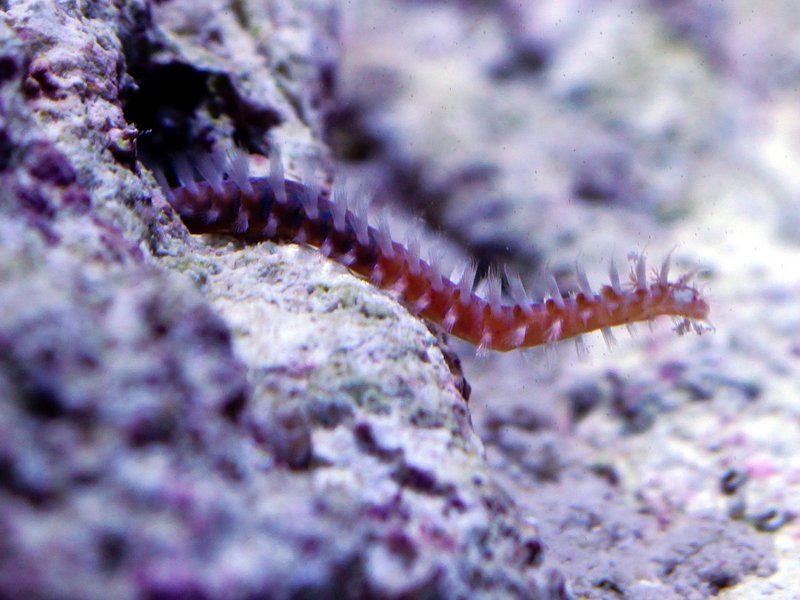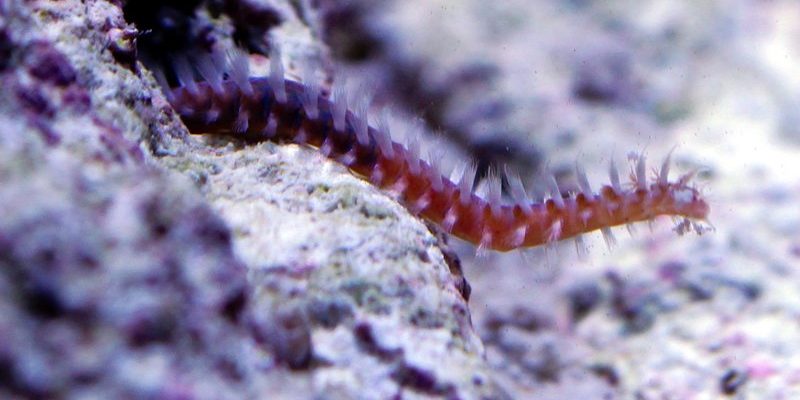
So, how do these worms end up in your tank? That’s a great question! Just like when a friend shows up with a surprise plus-one, bristle worms often hitch a ride on live rock, coral, or even plants that you might introduce to your aquarium. Understanding their invasion tactics is crucial if you want to keep your tank healthy and thriving. Let me break down the details for you, so you can be prepared!
What Are Bristle Worms?
If you’ve never heard of bristle worms, let’s start with the basics. These creatures are segmented worms that belong to the family **Polychaeta**. They have varying colors, but many are reddish-brown and can grow quite long, sometimes up to a foot! They typically have tiny hair-like bristles called *setae* covering their bodies. While they may look a bit creepy, they actually play a role in the ecosystem.
But here’s the catch: their role can turn pretty negative when they invade your aquarium in large numbers. They are scavengers at heart, munching on decaying organic matter. In small amounts, this can help keep your tank clean. However, if they multiply unchecked, they can start competing for food with your fish and corals. Imagine having a bunch of relatives showing up for dinner, leaving you with barely enough food for the family!
How Do Bristle Worms Get Into Your Aquarium?
You might be wondering how exactly these little invaders find their way into your tank. The most common method is through **live rock** and **live sand**. These materials can contain bristle worm eggs or even full-grown worms. When you add them to your aquarium, voila! You’ve just rolled out the welcome mat for them.
Another way these worms sneak in is through new aquatic plants or even fish. If you purchase these creatures from a less-than-reputable source, there’s a chance they’ve come along for the ride. It’s similar to how you might pick up a new tune from your favorite band; sometimes, it’s unexpected but it sticks with you.
To minimize the risk, consider buying from trusted suppliers who inspect their products for pests. Doing a little research can save you a lot of headaches down the line!
Identifying Bristle Worms
Now that you know how they get into your aquarium, let’s talk about spotting them. You might first notice bristle worms at night when they come out to scavenge. They can be a bit shy during the day, hiding among rocks and crevices. So, keep your eye out!
Here are some signs you have bristle worms:
- Appearance: They are long, thin, and often have a bristly texture.
- Behavior: They tend to emerge after your lights go out.
- Increase in algae: If you see more algae growing in your aquarium, that could indicate that bristle worms are hogging nutrients.
If you notice these signs, don’t panic! Not all bristle worms are bad. Just remember, moderation is key. A small population can even help keep your aquarium clean.
Why Bristle Worms Can Be Problematic
While bristle worms can be beneficial, they can quickly turn into a nuisance. When their numbers swell, they can disrupt the balance of your aquarium. Here are a few reasons why you might want to keep them in check:
1. **Competition for Food:** They eat **detritus**, a mixture of decomposing plant and animal parts. If they’re consuming too much, your fish and corals might not get the nutrients they need to thrive. It’s like having too many customers at a buffet—everyone ends up leaving hungry.
2. **Damage to Corals:** Some species of bristle worms are known to nibble on corals, which can lead to unsightly damage. If you start seeing your corals looking less than vibrant, it might be a sign to check for these pests.
3. **Unsightly Appearance:** Let’s be honest, many aquarium enthusiasts don’t want to see creepy-crawly worms waving around in their tank. It can diminish the visual appeal of your beautiful setup.
Managing Bristle Worm Populations
If you’ve discovered bristle worms causing trouble in your tank, you might be wondering how to manage their populations properly. Here are some effective strategies:
- Regular Maintenance: Conduct regular tank clean-ups to minimize leftover food and waste that might attract worms.
- Natural Predators: Introduce natural predators like **wrasses** or **dottybacks** that enjoy snacking on these worms. Think of it as bringing in the cleanup crew!
- Traps: You can set up traps designed specifically for bristle worms. These can help catch them without harming other aquarium inhabitants.
Keeping an eye on the number of bristle worms in your aquarium is crucial. A little monitoring can go a long way in ensuring a healthy environment for your fish and corals.
Preventing Bristle Worm Infestation
Prevention is often easier than dealing with an infestation down the line. Here are some effective ways to stop bristle worms from moving in:
1. **Quarantine New Additions:** Always quarantine new fish, corals, or rock before introducing them to your main tank. This gives you a chance to observe them and ensure they’re pest-free.
2. **Buy from Reputable Sources:** Ensure your live rock and corals come from reliable vendors who inspect their products. Think of it as choosing a trusted restaurant; you want to make sure your meal is safe and tasty.
3. **Control Feeding:** Be mindful of how much you’re feeding your fish. Overfeeding can lead to excess waste and leftover food that attracts bristle worms.
By taking these steps, you can help keep your aquarium healthy and beautiful, without any unwelcome surprises.
Bristle worms might seem like small, harmless creatures at first, but they can quickly become a bigger issue if left unchecked. By understanding how they invade, identifying them early, and taking proactive steps, you can keep your saltwater aquarium thriving. Remember, it’s all about balance—having a few bristle worms can be beneficial, but too many is a sign you need to take action. With a little care and attention, your aquarium can continue to be a stunning display of underwater life, free from unwanted guests!

